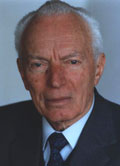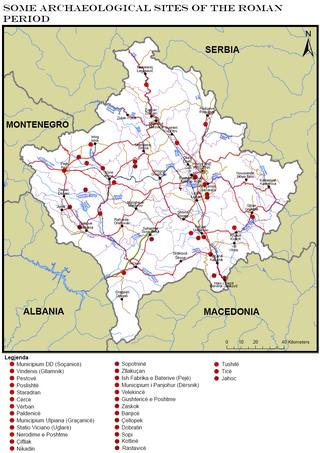
The Fadil Vokrri Stadium, previously known as Prishtina City Stadium, is a multi-purpose stadium in Prishtina, Kosovo, which is used mostly for football matches and is the home ground of FC Prishtina and Kosovo national football team. The stadium has a capacity of 13,980.

Pristina is the capital and largest city of Kosovo. It is the administrative center of the eponymous municipality and district.

Kosovo is a small and landlocked country in Southeastern Europe. The country is strategically positioned in the center of the Balkan Peninsula enclosed by Montenegro to the west, Serbia to the north and east, North Macedonia to the southeast, and Albania to the southwest. It has no direct access to the Mediterranean Sea but its rivers flow into three seas, the Adriatic, Aegean and Black Sea.

Mark Krasniqi was an Kosovar Albanian ethnographist, publicist, writer and translator who did most of his work while residing in Yugoslavia.
Tourism in Kosovo is characterized by archaeological heritage from Illyrian, Dardanian, Roman, Byzantine, Serbian and Ottoman times, traditional Albanian and Serbian cuisine, architecture, religious heritage, traditions, and natural landscapes. Kosovo is situated in south-eastern Europe. With its central position in the Balkans, it serves as a link in the connection between central and south Europe, the Adriatic Sea, and Black Sea.
Classical music in Kosovo refers to the art music cultivated in Kosovo. The roots of classical music in Kosovo are found in the 1940s and include the time period from the times when Kosovo was part of Yugoslavia to this day. It can be said that there is a tradition of classical music in Kosovo, however, compared to other Balkan countries and especially European countries this tradition is younger. Classical music in Kosovo reaches back about 70 years. Even though in a short period of time, this music has evolved, passing through generations of composers and artists. In his book Albanian: Zhvillimi i stileve në veprat e kompozitorëve shqiptarë të Kosovës, Engjëll Berisha comments:
"The diversity of styles in Albanian music [of Kosovo], its national patterns with sound idea-aesthetic foundations are a characteristic of the European musical reality, so many many works are of interest abroad, too, because during this relatively short period Albanian classical music in Kosovo has compensated for the delay in its development."

Archaeology of Kosovo as a field of study and research was started in the second half of the 20th century. Kosovo's field of archaeology has developed in tandem with the historical study, studies of ancient authors' sources, classic philological studies, theological data research, topographic studies and ground survey, analysis of toponyms, deciphering of epigraphic and historiographic data. First data about antique monuments in Kosovo, were documented from the end of the 19th until the beginning of the Second World War, a time period when Kosovo was visited by researchers, guides, and archaeologists such as: Evans, Boue, Hahn, Kanitz, Tomaschek, Domaschevski, Arpad, Vulic, Jirecek, Patsch, Domenico Mustilli, etc.

The forests of Kosovo make up about 44.7% Agricultural land comprises 53% of Kosovo's total land area and forests 44.7% of the entire surface of the territory. Most of the forests are located in southwestern Kosovo, including the outskirts of Peja, Deçan, Istog, Junik and Gjakova and are protected by particular laws of the Kosovar Constitution. There are several types of forests in Kosovo and they are mostly represented by pinnate ones.

The Roman heritage sites in Kosovo represent a multitude of monuments of material and spiritual culture, which reflect the Roman period in this region. Among them, a special place is occupied by those that represent the development of art, such as the plastic monuments that are more frequent, and at the same time occupy an important place, because with the presentation of figures in relief and with numerous inscriptions they speak to us enough for this period.
Prishtina is the epicenter of sport in Kosovo, where activity is organized across amateur and professional levels, sport organizations and clubs, regulated by the Kosovo Olympic Committee and the Ministry of Culture, Youth and Sport. Prishtina is known for their success in Sports such as Football, Boxing, Basketball and Futsal. They compete for five seasons in the Yugoslav First League between 1983 and 1988 in which their best finish came in their first ever season in 1983-84 finishing in 8th place. In the same season they reached the Mitropa Cup finals of 1983-84, were FC Prishtina finished Runners up to Eisenstadt from Austria. as well as reaching the semifinals in the Yugoslav Cup in 1987-88.

The Bazaar of Prishtina, Kosovo, was the core merchandising center of the Old Prishtina since the 15th century, when it was built. It played a significant role in the physical, economic, and social development of Pristina. The Old Bazaar was destroyed during the 1950s and 1960s, following the modernization slogan of "Destroy the old, build the new". In its place, buildings of Kosovo Assembly, Municipality of Prishtina, PTT, and Brotherhood and Unity socialist square were built. Nowadays, instead of PTT building resides the Government of Kosovo building. Only few historical buildings, such as the Bazaar Mosque and ruins of the Bazaar Hammam have remained from the Bazaar complex. Since then, Prishtina has lost part of its identity, and its cultural heritage has been scattered.

The media in Pristina includes some of the most important newspapers, largest publishing houses and most prolific television studio. Pristina is the largest communications center of media in Kosova. Almost all of the major media organizations in Kosova are based in Pristina.

The National Theatre of Kosovo was founded in 1946 in the city of Prizren, Kosovo. It is the highest ranked theatre institution in the country, with the largest number of productions. The National Theatre is the only public theatre in Kosovo and therefore it is financed by Ministry of Culture, Youth and Sport. This theatre has produced more than 400 premieres which have been watched by more than 3 million spectators.

As the capital city of Kosovo, Pristina is the heart of the cultural and artistic development of all Albanians that live in Kosovo. The department of cultural affairs is just one of the segments that arranges the cultural events, which make Pristina one of the cities with the most emphasized cultural and artistic traditions.
Music composition and composers in Pristina refers to music composition and composers who have left their mark in Pristina. The importance of Kosovan Folklore on the different genres, their development and their popularity. As referring to genres as a categorization would not cover all compositions and composers in a fair way, a highlight of every composers work and different genres is provided because of the different genres a composers work has included throughout the years.
The architecture of Kosovo dates back to the Neolithic period and includes the Copper, Bronze and Iron Ages, Antiquity and the Medieval period. It has been influenced by the presence of different civilizations and religions as evidenced by the structures which have survived to this day. Local builders have combined building techniques of conquering empires with the materials at hand and the existing conditions to develop their own varieties of dwellings.

Kosovo is characterised by a diverse biodiversity and an abundance of different ecosystems and habitats determined by the climate along with the geology and hydrology. Predominantly mountainous, it is located at the center of the Balkan Peninsula bounded by Montenegro to the west, Serbia to the north and east, North Macedonia to the southeast, and Albania to the southwest.
Blendi Xhemajl Baftiu is a Kosovan professional footballer who plays as an attacking midfielder for Kosovan club FC Drita and the Kosovo national team.
Pajazit Nushi was a university professor, psychologist and scientific and social-political worker from Gjakova, Kosova. Member of the Academy of Sciences and Arts of Kosovo.
















